fuel TOYOTA GT86 2020 Warranties & Maintenance Guides (in English)
[x] Cancel search | Manufacturer: TOYOTA, Model Year: 2020, Model line: GT86, Model: TOYOTA GT86 2020Pages: 260, PDF Size: 8.54 MB
Page 11 of 260
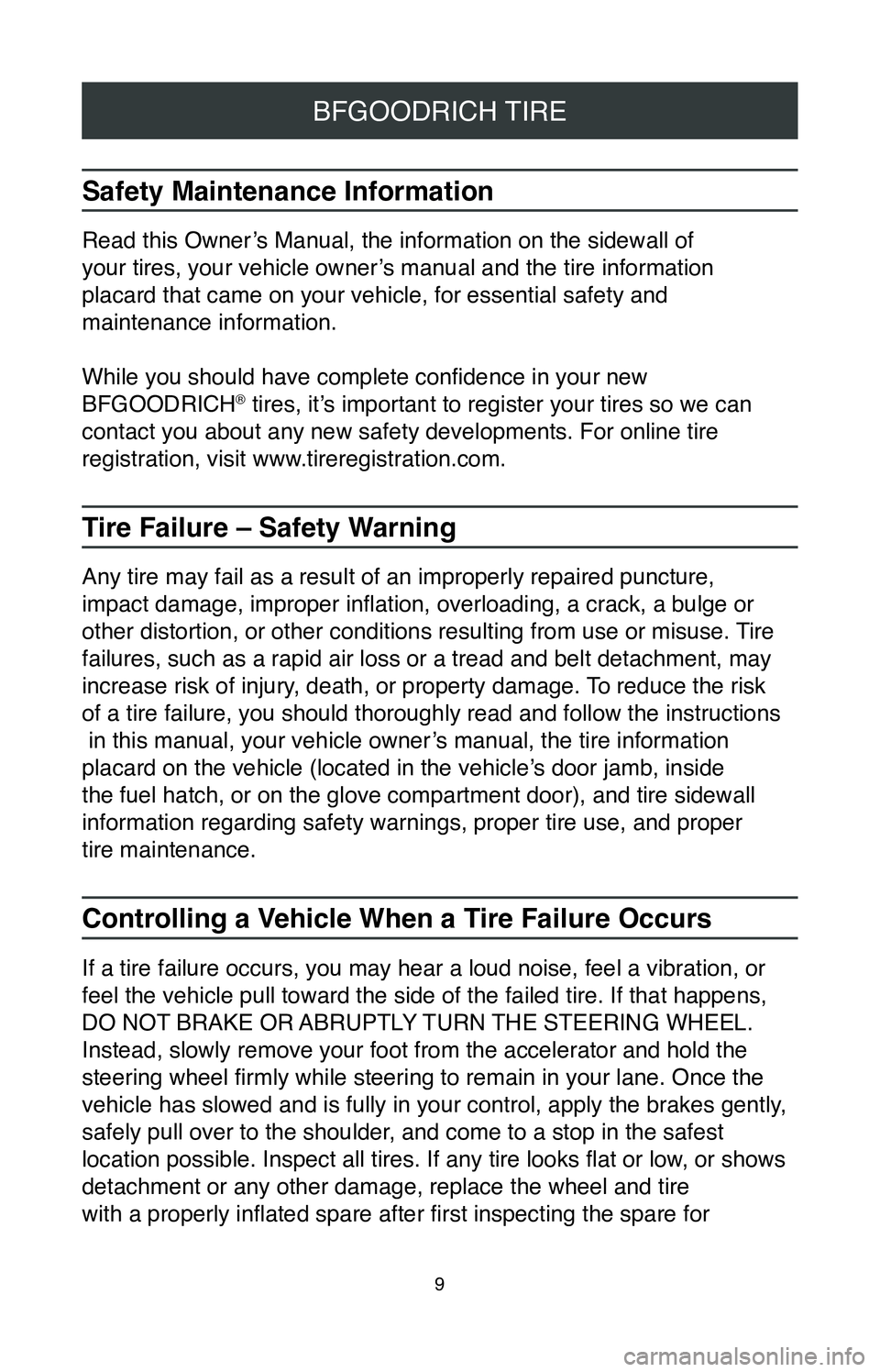
9
BFGOODRICH TIRE
Safety Maintenance Information
Read this Owner’s Manual, the information on the sidewall of
your tires, your vehicle owner’s manual and the tire information
placard that came on your vehicle, for essential safety and
maintenance information.
While you should have complete confidence in your new
BFGOODRICH
® tires, it’s important to register your tires so we can
contact you about any new safety developments. For online tire
registration, visit www.tireregistration.com.
Tire Failure – Safety Warning
Any tire may fail as a result of an improperly repaired puncture,
impact damage, improper inflation, overloading, a crack, a bulge or
other distortion, or other conditions resulting from use or misuse. Tire
failures, such as a rapid air loss or a tread and belt detachment, may
increase risk of injury, death, or property damage. To reduce the risk
of a tire failure, you should thoroughly read and follow the instruction\
s
in this manual, your vehicle owner’s manual, the tire information
placard on the vehicle (located in the vehicle’s door jamb, inside
the fuel hatch, or on the glove compartment door), and tire sidewall
information regarding safety warnings, proper tire use, and proper
tire maintenance.
Controlling a Vehicle When a Tire Failure Occurs
If a tire failure occurs, you may hear a loud noise, feel a vibration, o\
r
feel the vehicle pull toward the side of the failed tire. If that happen\
s,
DO NOT BRAKE OR ABRUPTLY TURN THE STEERING WHEEL.
Instead, slowly remove your foot from the accelerator and hold the
steering wheel firmly while steering to remain in your lane. Once the
vehicle has slowed and is fully in your control, apply the brakes gently\
,
safely pull over to the shoulder, and come to a stop in the safest
location possible. Inspect all tires. If any tire looks flat or low , or shows
detachment or any other damage, replace the wheel and tire
with a properly inflated spare after first inspecting the spare for
Page 12 of 260
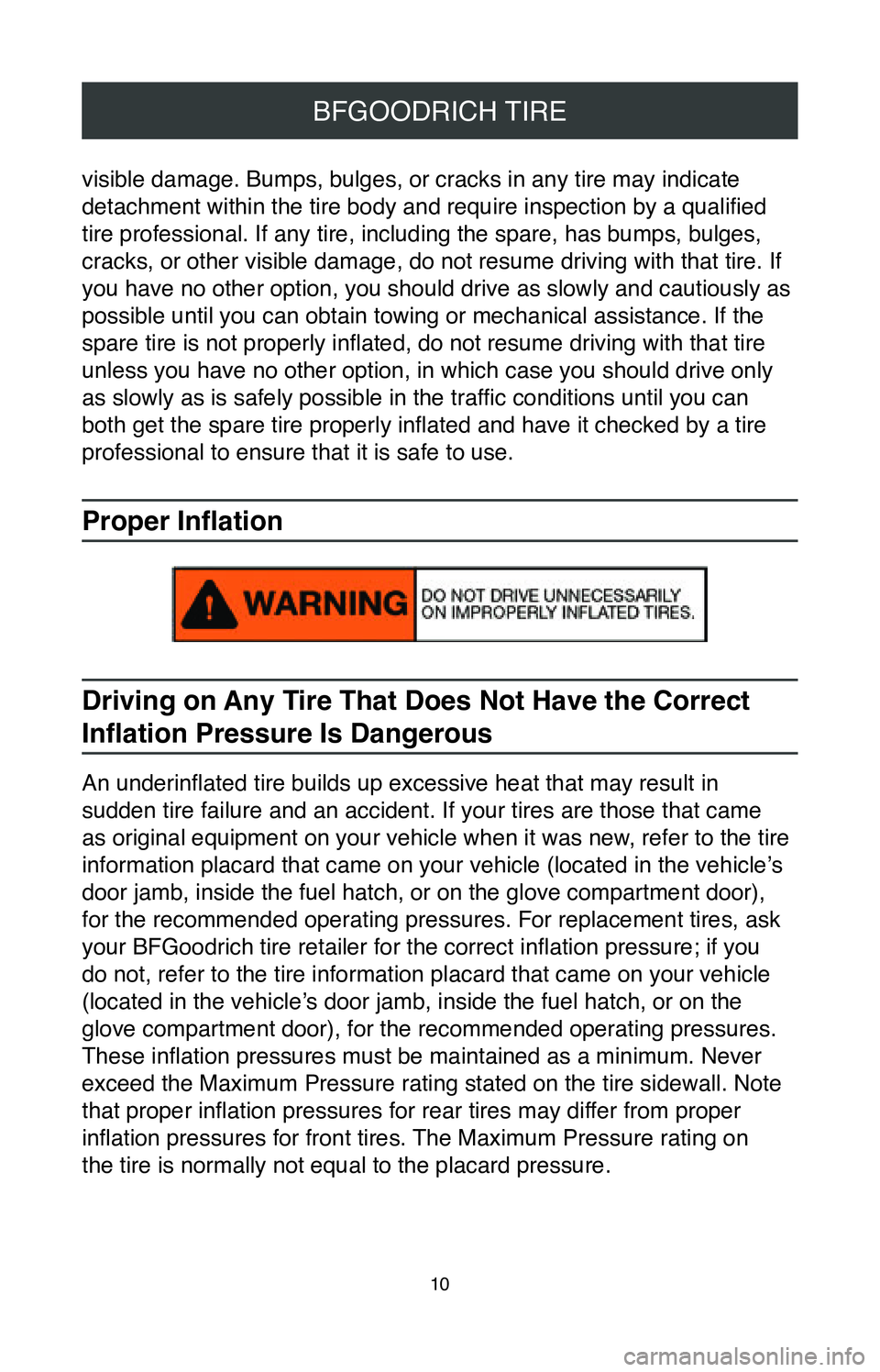
10
BFGOODRICH TIRE
visible damage. Bumps, bulges, or cracks in any tire may indicate
detachment within the tire body and require inspection by a qualified
tire professional. If any tire, including the spare, has bumps, bulges, \
cracks, or other visible damage, do not resume driving with that tire. I\
f
you have no other option, you should drive as slowly and cautiously as
possible until you can obtain towing or mechanical assistance. If the
spare tire is not properly inflated, do not resume driving with that tire
unless you have no other option, in which case you should drive only
as slowly as is safely possible in the traffic conditions until you can
both get the spare tire properly inflated and have it checked by a tire
professional to ensure that it is safe to use.
Proper Inflation
Driving on Any Tire That Does Not Have the Correct
Inflation Pressure Is Dangerous
An underinflated tire builds up excessive heat that may result in
sudden tire failure and an accident. If your tires are those that came
as original equipment on your vehicle when it was new, refer to the tire
information placard that came on your vehicle (located in the vehicle’s
door jamb, inside the fuel hatch, or on the glove compartment door),
for the recommended operating pressures. For replacement tires, ask
your BFGoodrich tire retailer for the correct inflation pressure; if you
do not, refer to the tire information placard that came on your vehicle \
(located in the vehicle’s door jamb, inside the fuel hatch, or on the
glove compartment door), for the recommended operating pressures.
These inflation pressures must be maintained as a minimum. Never
exceed the Maximum Pressure rating stated on the tire sidewall. Note
that proper inflation pressures for rear tires may differ from proper
inflation pressures for front tires. The Maximum Pressure rating on
the tire is normally not equal to the placard pressure.
Page 14 of 260
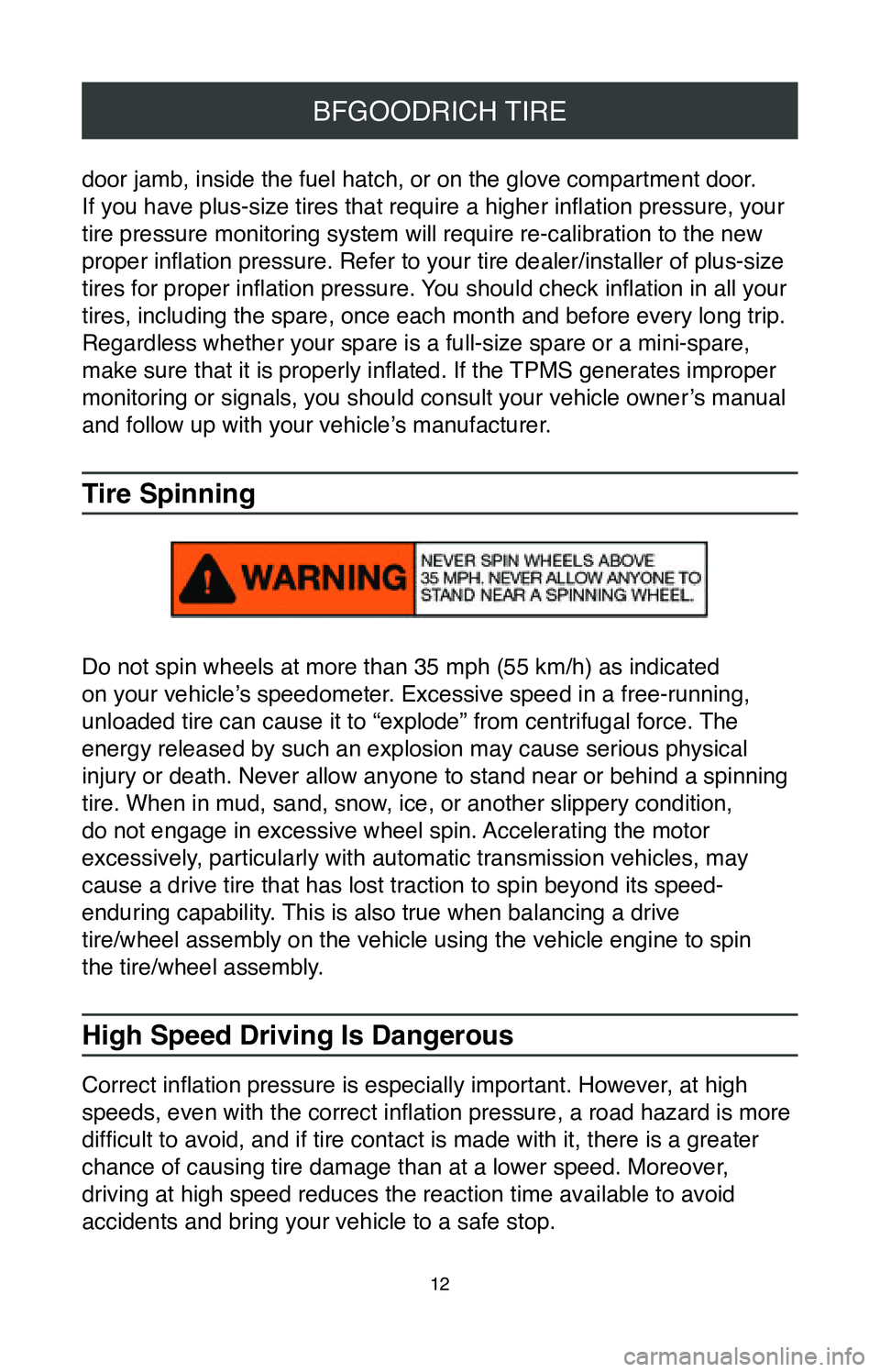
12
BFGOODRICH TIRE
door jamb, inside the fuel hatch, or on the glove compartment door.
If you have plus-size tires that require a higher inflation pressure, your
tire pressure monitoring system will require re-calibration to the new
proper inflation pressure. Refer to your tire dealer/installer of plus-size
tires for proper inflation pressure. You should check inflation in all your
tires, including the spare, once each month and before every long trip. \
Regardless whether your spare is a full-size spare or a mini-spare,
make sure that it is properly inflated. If the TPMS generates improper
monitoring or signals, you should consult your vehicle owner’s manual
and follow up with your vehicle’s manufacturer.
Tire Spinning
Do not spin wheels at more than 35 mph (55 km/h) as indicated
on your vehicle’s speedometer. Excessive speed in a free-running,
unloaded tire can cause it to “explode” from centrifugal force. The
energy released by such an explosion may cause serious physical
injury or death. Never allow anyone to stand near or behind a spinning
tire. When in mud, sand, snow, ice, or another slippery condition,
do not engage in excessive wheel spin. Accelerating the motor
excessively, particularly with automatic transmission vehicles, may
cause a drive tire that has lost traction to spin beyond its speed-
enduring capability. This is also true when balancing a drive
tire/wheel assembly on the vehicle using the vehicle engine to spin
the tire/wheel assembly.
High Speed Driving Is Dangerous
Correct inflation pressure is especially important. However, at high
speeds, even with the correct inflation pressure, a road hazard is more
difficult to avoid, and if tire contact is made with it, there is a greater
chance of causing tire damage than at a lower speed. Moreover,
driving at high speed reduces the reaction time available to avoid
accidents and bring your vehicle to a safe stop.
Page 20 of 260
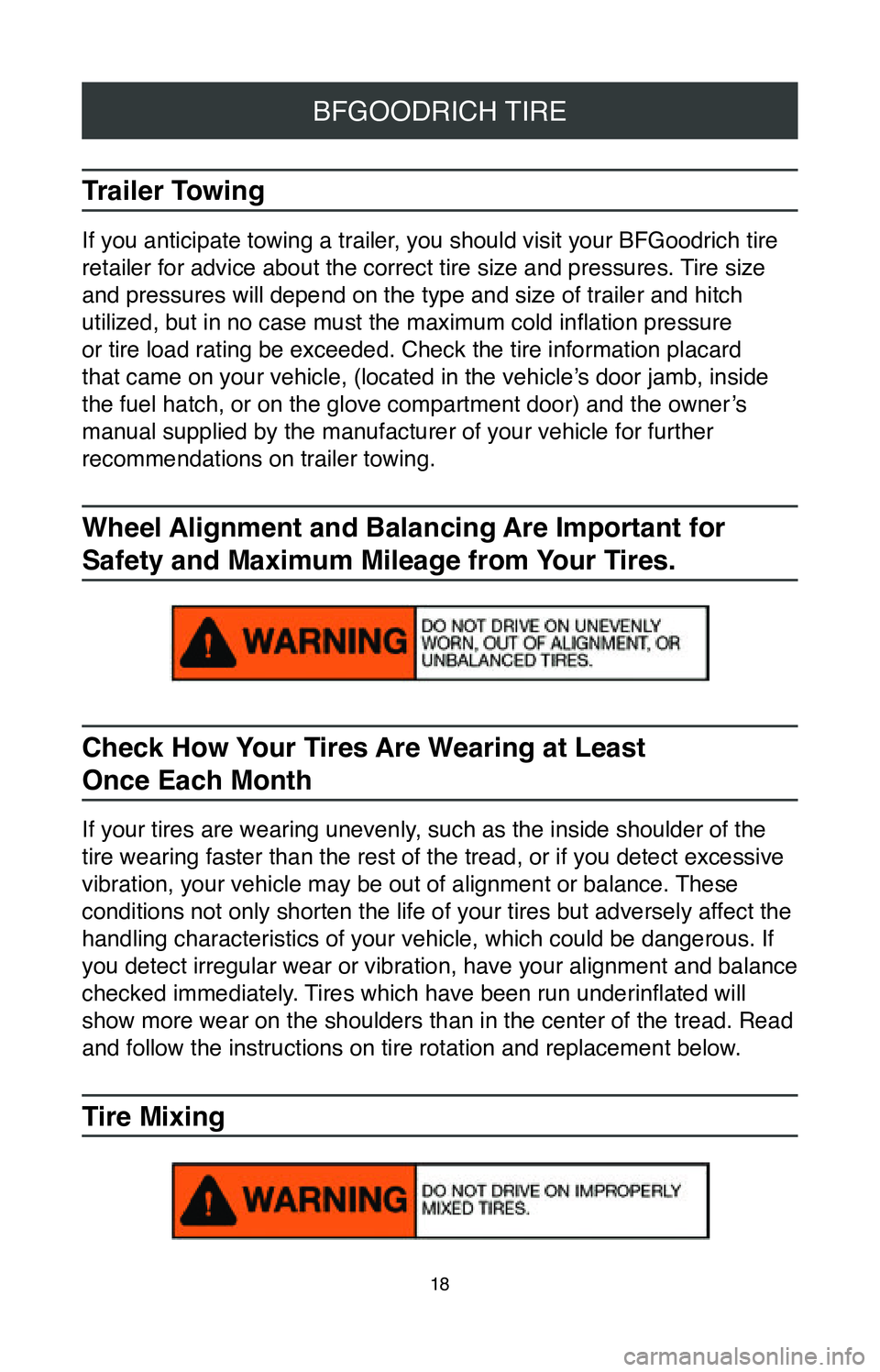
18
BFGOODRICH TIRE
Trailer Towing
If you anticipate towing a trailer, you should visit your BFGoodrich tire
retailer for advice about the correct tire size and pressures. Tire size
and pressures will depend on the type and size of trailer and hitch
utilized, but in no case must the maximum cold inflation pressure
or tire load rating be exceeded. Check the tire information placard
that came on your vehicle, (located in the vehicle’s door jamb, inside
the fuel hatch, or on the glove compartment door) and the owner’s
manual supplied by the manufacturer of your vehicle for further
recommendations on trailer towing.
Wheel Alignment and Balancing Are Important for
Safety and Maximum Mileage from Your Tires.
Check How Your Tires Are Wearing at Least
Once Each Month
If your tires are wearing unevenly, such as the inside shoulder of the
tire wearing faster than the rest of the tread, or if you detect excessi\
ve
vibration, your vehicle may be out of alignment or balance. These
conditions not only shorten the life of your tires but adversely affect the
handling characteristics of your vehicle, which could be dangerous. If
you detect irregular wear or vibration, have your alignment and balance
checked immediately. Tires which have been run underinflated will
show more wear on the shoulders than in the center of the tread. Read
and follow the instructions on tire rotation and replacement below.
Tire Mixing
Page 36 of 260
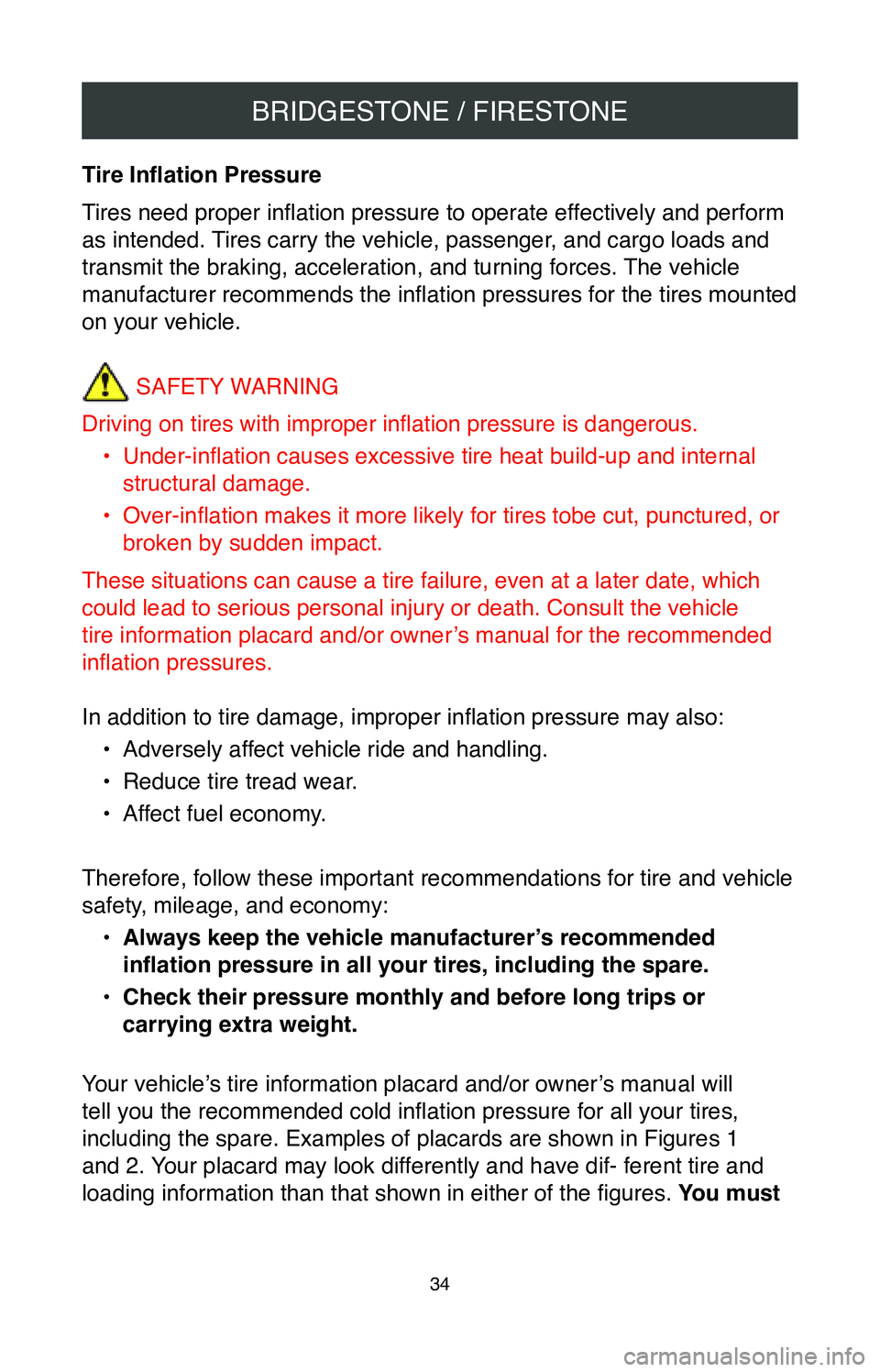
BRIDGESTONE / FIRESTONE
34
Tire Inflation Pressure
Tires need proper inflation pressure to operate effectively and perform
as intended. Tires carry the vehicle, passenger, and cargo loads and
transmit the braking, acceleration, and turning forces. The vehicle
manufacturer recommends the inflation pressures for the tires mounted
on your vehicle.SAFETY WARNING
Driving on tires with improper inflation pressure is dangerous. •
Under-inflation causes excessive tire heat build-up and internal
structural damage.
•
Over-inflation makes it more likely for tires tobe cut, punctured, or
broken by sudden impact.
These situations can cause a tire failure, even at a later date, which
could lead to serious personal injury or death. Consult the vehicle
tire information placard and/or owner’s manual for the recommended
inflation pressures.
In addition to tire damage, improper inflation pressure may also: •
Adversely affect vehicle ride and handling.
•
Reduce tire tread wear.
•
Affect fuel economy.
Therefore, follow these important recommendations for tire and vehicle
safety, mileage, and economy: •
Always keep the vehicle manufacturer’s recommended
inflation pressure in all your tires, including the spare.
•
Check their pressure monthly and before long trips or
carrying extra weight.
Your vehicle’s tire information placard and/or owner’s manual will
tell you the recommended cold inflation pressure for all your tires,
including the spare. Examples of placards are shown in Figures 1
and 2. Your placard may look differently and have dif- ferent tire and
loading information than that shown in either of the figures. You must
Page 76 of 260
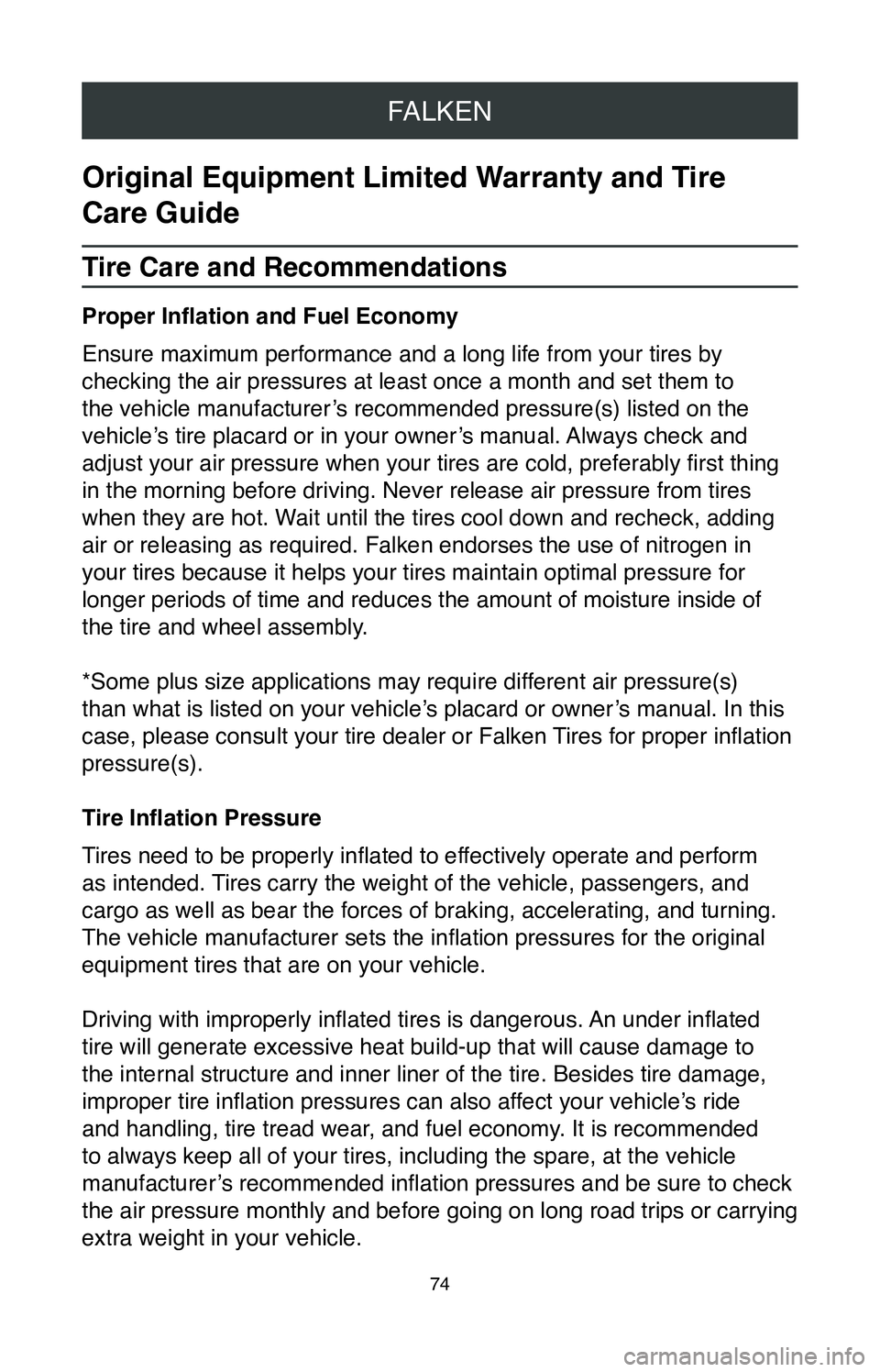
FALKEN
74
Original Equipment Limited Warranty and Tire
Care Guide
Tire Care and Recommendations
Proper Inflation and Fuel Economy
Ensure maximum performance and a long life from your tires by
checking the air pressures at least once a month and set them to
the vehicle manufacturer’s recommended pressure(s) listed on the
vehicle’s tire placard or in your owner’s manual. Always check and
adjust your air pressure when your tires are cold, preferably first thing
in the morning before driving. Never release air pressure from tires
when they are hot. Wait until the tires cool down and recheck, adding
air or releasing as required. Falken endorses the use of nitrogen in
your tires because it helps your tires maintain optimal pressure for
longer periods of time and reduces the amount of moisture inside of
the tire and wheel assembly.
*Some plus size applications may require different air pressure(s)
than what is listed on your vehicle’s placard or owner’s manual. In this
case, please consult your tire dealer or Falken Tires for proper inflation
pressure(s).
Tire Inflation Pressure
Tires need to be properly inflated to effectively operate and perform
as intended. Tires carry the weight of the vehicle, passengers, and
cargo as well as bear the forces of braking, accelerating, and turning. \
The vehicle manufacturer sets the inflation pressures for the original
equipment tires that are on your vehicle.
Driving with improperly inflated tires is dangerous. An under inflated
tire will generate excessive heat build-up that will cause damage to
the internal structure and inner liner of the tire. Besides tire damage,\
improper tire inflation pressures can also affect your vehicle’s ride
and handling, tire tread wear, and fuel economy. It is recommended
to always keep all of your tires, including the spare, at the vehicle
manufacturer’s recommended inflation pressures and be sure to check
the air pressure monthly and before going on long road trips or carrying
extra weight in your vehicle.
Page 95 of 260
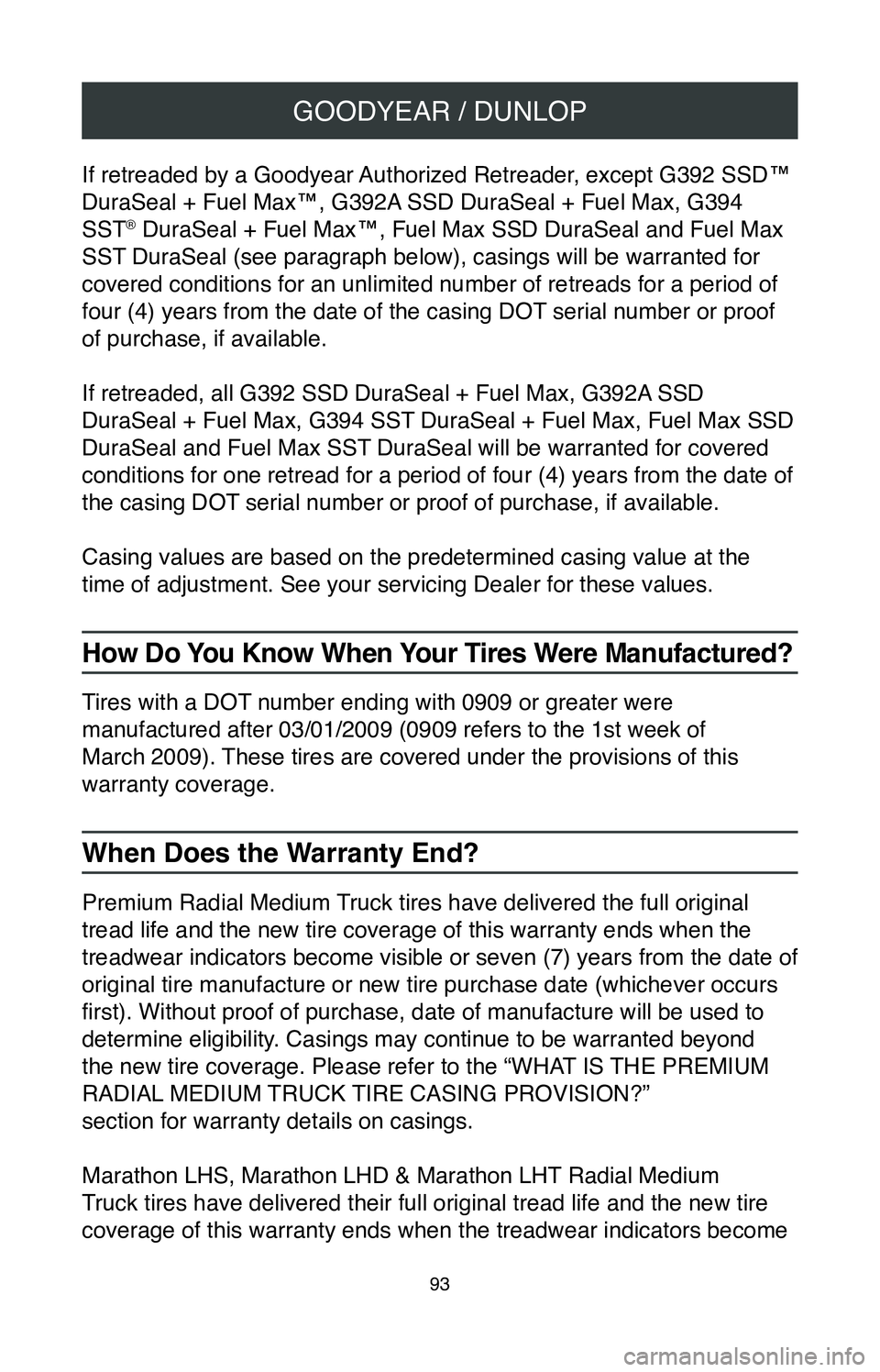
GOODYEAR / DUNLOP
93
If retreaded by a Goodyear Authorized Retreader, except G392 SSD™
DuraSeal + Fuel Max™, G392A SSD DuraSeal + Fuel Max, G394
SST
® DuraSeal + Fuel Max™, Fuel Max SSD DuraSeal and Fuel Max
SST DuraSeal (see paragraph below), casings will be warranted for
covered conditions for an unlimited number of retreads for a period of
four (4) years from the date of the casing DOT serial number or proof
of purchase, if available.
If retreaded, all G392 SSD DuraSeal + Fuel Max, G392A SSD
DuraSeal + Fuel Max, G394 SST DuraSeal + Fuel Max, Fuel Max SSD
DuraSeal and Fuel Max SST DuraSeal will be warranted for covered
conditions for one retread for a period of four (4) years from the date of
the casing DOT serial number or proof of purchase, if available.
Casing values are based on the predetermined casing value at the
time of adjustment. See your servicing Dealer for these values.
How Do You Know When Your Tires Were Manufactured?
Tires with a DOT number ending with 0909 or greater were
manufactured after 03/01/2009 (0909 refers to the 1st week of
March 2009). These tires are covered under the provisions of this
warranty coverage.
When Does the Warranty End?
Premium Radial Medium Truck tires have delivered the full original
tread life and the new tire coverage of this warranty ends when the
treadwear indicators become visible or seven (7) years from the date of
original tire manufacture or new tire purchase date (whichever occurs
first). Without proof of purchase, date of manufacture will be used to
determine eligibility. Casings may continue to be warranted beyond
the new tire coverage. Please refer to the “WHAT IS THE PREMIUM
RADIAL MEDIUM TRUCK TIRE CASING PROVISION?”
section for warranty details on casings.
Marathon LHS, Marathon LHD & Marathon LHT Radial Medium
Truck tires have delivered their full original tread life and the new tir\
e
coverage of this warranty ends when the treadwear indicators become
Page 125 of 260
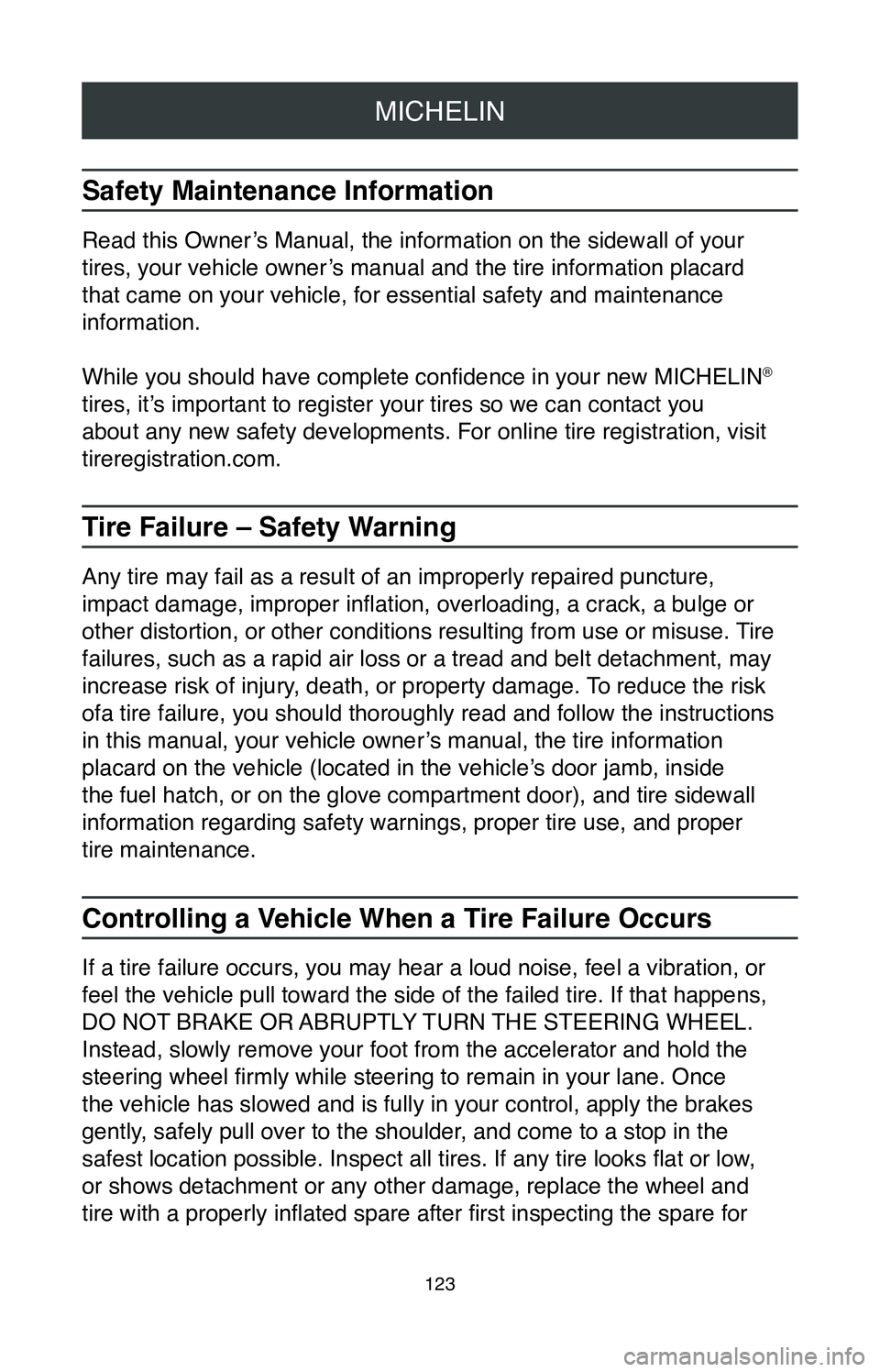
MICHELIN
123
Safety Maintenance Information
Read this Owner’s Manual, the information on the sidewall of your
tires, your vehicle owner’s manual and the tire information placard
that came on your vehicle, for essential safety and maintenance
information.
While you should have complete confidence in your new MICHELIN
®
tires, it’s important to register your tires so we can contact you
about any new safety developments. For online tire registration, visit
tireregistration.com.
Tire Failure – Safety Warning
Any tire may fail as a result of an improperly repaired puncture,
impact damage, improper inflation, overloading, a crack, a bulge or
other distortion, or other conditions resulting from use or misuse. Tire
failures, such as a rapid air loss or a tread and belt detachment, may
increase risk of injury, death, or property damage. To reduce the risk
ofa tire failure, you should thoroughly read and follow the instructions\
in this manual, your vehicle owner’s manual, the tire information
placard on the vehicle (located in the vehicle’s door jamb, inside
the fuel hatch, or on the glove compartment door), and tire sidewall
information regarding safety warnings, proper tire use, and proper
tire maintenance.
Controlling a Vehicle When a Tire Failure Occurs
If a tire failure occurs, you may hear a loud noise, feel a vibration, o\
r
feel the vehicle pull toward the side of the failed tire. If that happen\
s,
DO NOT BRAKE OR ABRUPTLY TURN THE STEERING WHEEL.
Instead, slowly remove your foot from the accelerator and hold the
steering wheel firmly while steering to remain in your lane. Once
the vehicle has slowed and is fully in your control, apply the brakes
gently, safely pull over to the shoulder, and come to a stop in the
safest location possible. Inspect all tires. If any tire looks flat or low ,
or shows detachment or any other damage, replace the wheel and
tire with a properly inflated spare after first inspecting the spare for
Page 126 of 260
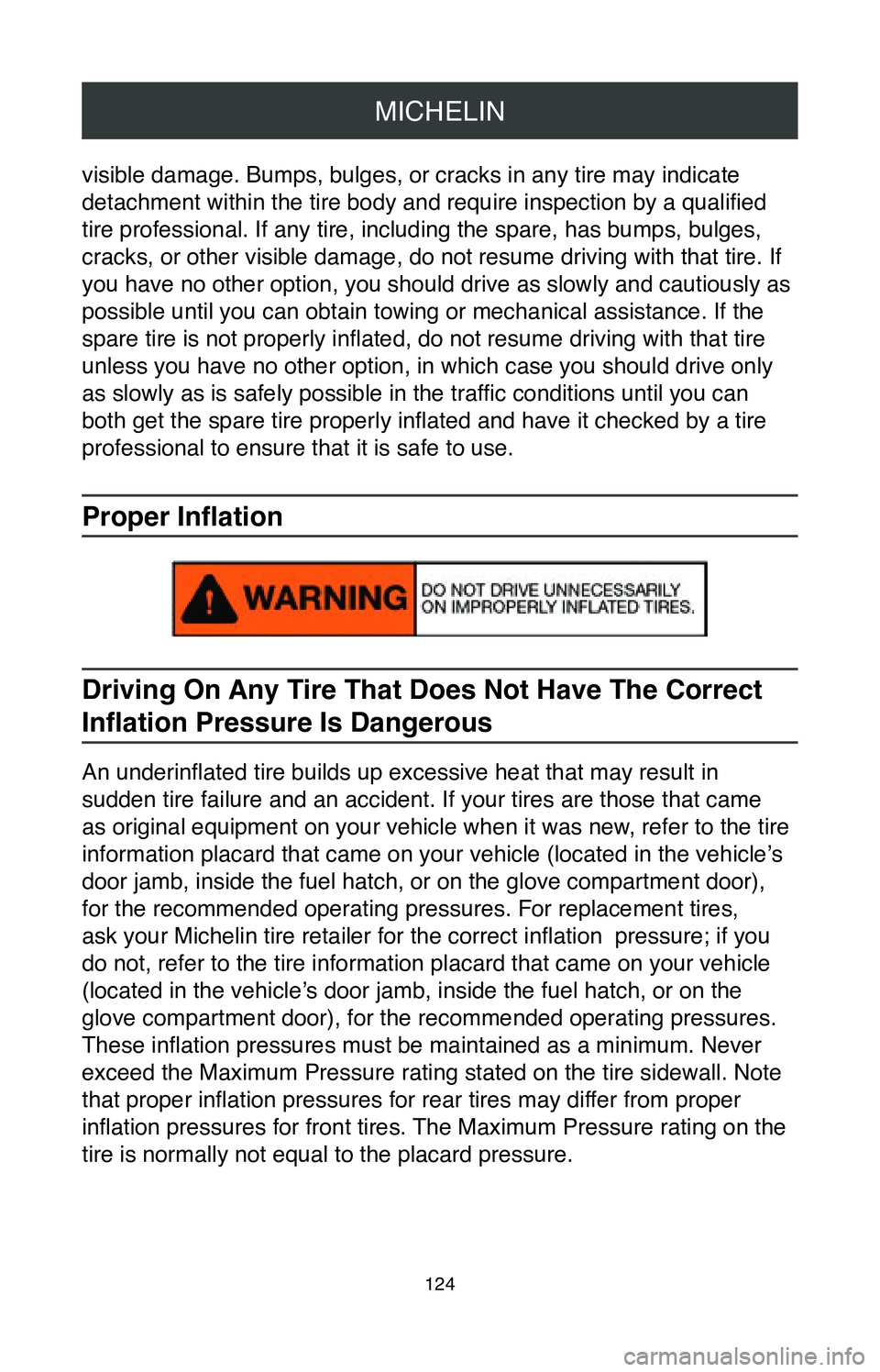
MICHELIN
124
visible damage. Bumps, bulges, or cracks in any tire may indicate
detachment within the tire body and require inspection by a qualified
tire professional. If any tire, including the spare, has bumps, bulges, \
cracks, or other visible damage, do not resume driving with that tire. I\
f
you have no other option, you should drive as slowly and cautiously as
possible until you can obtain towing or mechanical assistance. If the
spare tire is not properly inflated, do not resume driving with that tire
unless you have no other option, in which case you should drive only
as slowly as is safely possible in the traffic conditions until you can
both get the spare tire properly inflated and have it checked by a tire
professional to ensure that it is safe to use.
Proper Inflation
Driving On Any Tire That Does Not Have The Correct
Inflation Pressure Is Dangerous
An underinflated tire builds up excessive heat that may result in
sudden tire failure and an accident. If your tires are those that came
as original equipment on your vehicle when it was new, refer to the tire
information placard that came on your vehicle (located in the vehicle’s
door jamb, inside the fuel hatch, or on the glove compartment door),
for the recommended operating pressures. For replacement tires,
ask your Michelin tire retailer for the correct inflation pressure; if you
do not, refer to the tire information placard that came on your vehicle \
(located in the vehicle’s door jamb, inside the fuel hatch, or on the
glove compartment door), for the recommended operating pressures.
These inflation pressures must be maintained as a minimum. Never
exceed the Maximum Pressure rating stated on the tire sidewall. Note
that proper inflation pressures for rear tires may differ from proper
inflation pressures for front tires. The Maximum Pressure rating on the
tire is normally not equal to the placard pressure.
Page 128 of 260
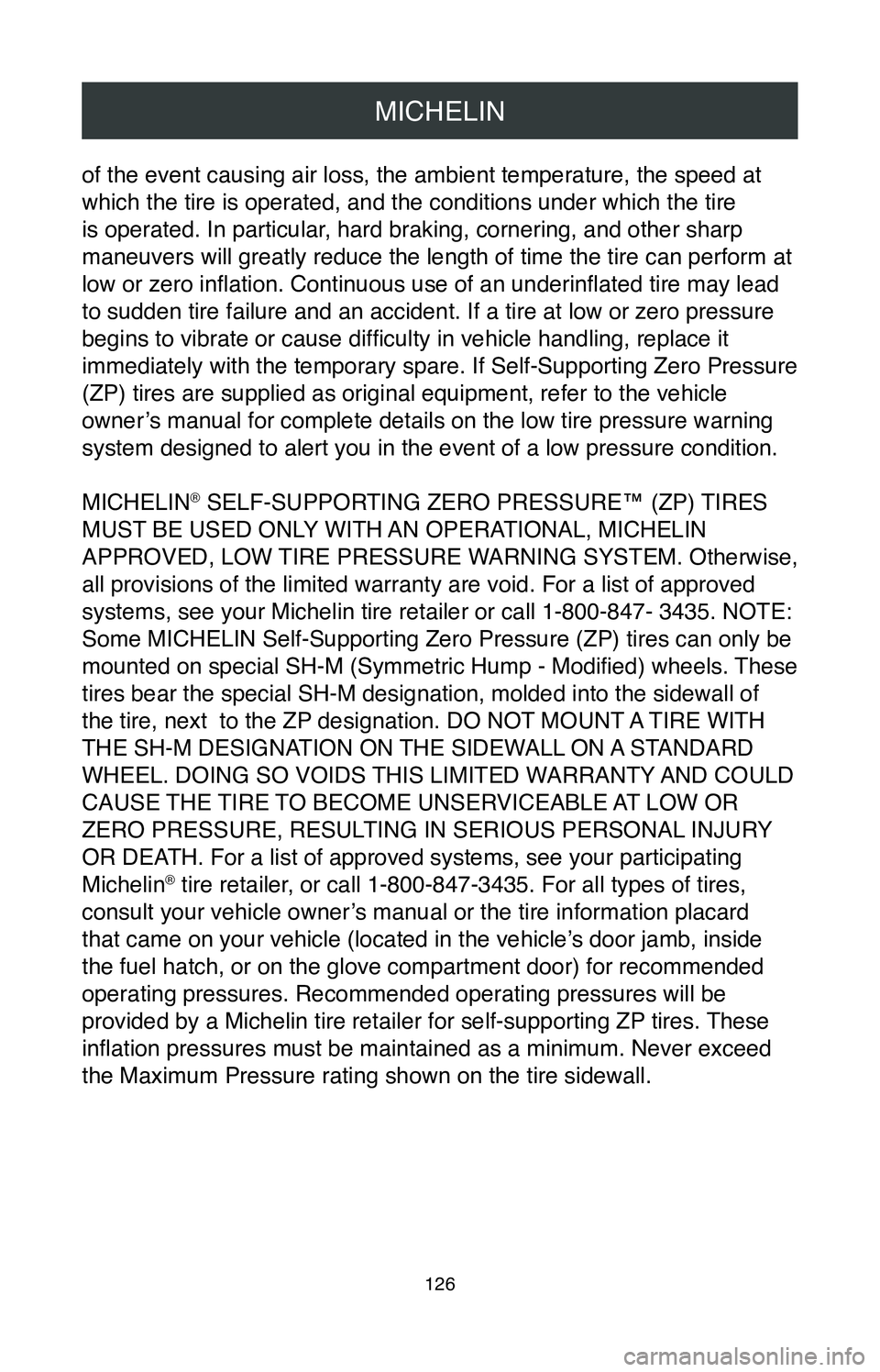
MICHELIN
126
of the event causing air loss, the ambient temperature, the speed at
which the tire is operated, and the conditions under which the tire
is operated. In particular, hard braking, cornering, and other sharp
maneuvers will greatly reduce the length of time the tire can perform at\
low or zero inflation. Continuous use of an underinflated tire may lead
to sudden tire failure and an accident. If a tire at low or zero pressur\
e
begins to vibrate or cause difficulty in vehicle handling, replace it
immediately with the temporary spare. If Self-Supporting Zero Pressure
(ZP) tires are supplied as original equipment, refer to the vehicle
owner’s manual for complete details on the low tire pressure warning
system designed to alert you in the event of a low pressure condition.
MICHELIN
® SELF-SUPPORTING ZERO PRESSURE™ (ZP) TIRES
MUST BE USED ONLY WITH AN OPERATIONAL, MICHELIN
APPROVED, LOW TIRE PRESSURE WARNING SYSTEM. Otherwise,
all provisions of the limited warranty are void. For a list of approved \
systems, see your Michelin tire retailer or call 1-800-847- 3435. NOTE:
Some MICHELIN Self-Supporting Zero Pressure (ZP) tires can only be
mounted on special SH-M (Symmetric Hump - Modified) wheels. These
tires bear the special SH-M designation, molded into the sidewall of
the tire, next to the ZP designation. DO NOT MOUNT A TIRE WITH
THE SH-M DESIGNATION ON THE SIDEWALL ON A STANDARD
WHEEL. DOING SO VOIDS THIS LIMITED WARRANTY AND COULD
CAUSE THE TIRE TO BECOME UNSERVICEABLE AT LOW OR
ZERO PRESSURE, RESULTING IN SERIOUS PERSONAL INJURY
OR DEATH. For a list of approved systems, see your participating
Michelin
® tire retailer, or call 1-800-847-3435. For all types of tires,
consult your vehicle owner’s manual or the tire information placard
that came on your vehicle (located in the vehicle’s door jamb, inside
the fuel hatch, or on the glove compartment door) for recommended
operating pressures. Recommended operating pressures will be
provided by a Michelin tire retailer for self-supporting ZP tires. These
inflation pressures must be maintained as a minimum. Never exceed
the Maximum Pressure rating shown on the tire sidewall.